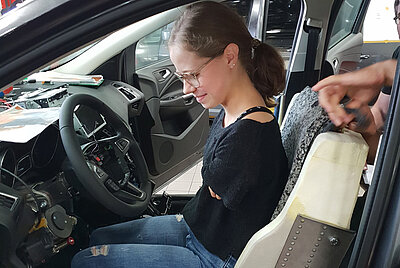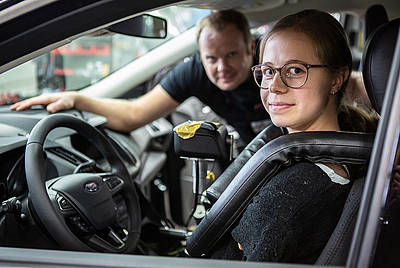Marina Schömig from Hettstadt near Würzburg is mobile. A Ford Kuga was individually converted and adapted for her. Among other things, the adjusted joystick steering makes this possible. The young woman has been training as a teacher for two years. In order to pursue her career later on (without always having to rely on people for help), the 19 year old needed her own car. Marina suffers from dysmelia – she was born with a malformed arm. Above all, Marina needs support with steering and shifting gears, and also with using the secondary functions of a car.
“Actually it was my father who discovered this,” she says. At first she tried to cope with driving a normal car but in the driving school it soon became clear that she would need joystick steering. Paravan found an expert who was technically qualified to make the required adjustments. From the outset an SUV seemed the best idea. “I actually saw the Ford in a parking lot,” remembers Marina Schömig. “Instead of ‘Kuga,’ I read it as ’Kiga’ – as in kindergarten. Then I knew it was my car.”
Marina Schömig got her driver’s license in the summer of 2017. After a medical assessment that certified her fitness to drive, she passed the theory part of the driving test at home. She did the practical part of the test at the mobility centre in Aichelau. Joystick steering adapted specially for her hand was fitted in the driving school car. “Despite her symptoms she has enough power in her hand to steer the car,” says Paravan driving instructor Igino Farnhamer. She completed the Space Drive training in just two and a half weeks. “It felt very strange,” she remembers, “as it was a very big car.” She soon got to grips with the technology. “I knew straight away that it was the right thing for me and it was fantastic fun into the bargain.”
The car is equipped, among other things, with Space Drive steering, automatic door opening, a made-to-measure seat and seat belt system, and voice control. “Not much more can be added to the electronics,” says Joachim Glück, a representative for technological advice at Paravan GmbH. This type of vehicle conversion takes a good 250 to 300 hours. In this case, the project was financed by an employment agency. “First the whole interior of the car was scanned by the Paravan engineer, so that they could adapt the future conversion in the best possible way,” reports technician Bernhard Dank, who implemented the vehicle conversion.
Marina Schömig from Hettstadt near Würzburg is mobile. A Ford Kuga was individually converted and adapted for her. Among other things, the adjusted joystick steering makes this possible. The young woman has been training as a teacher for two years. In order to pursue her career later on (without always having to rely on people for help), the 19 year old needed her own car. Marina suffers from dysmelia – she was born with a malformed arm. Above all, Marina needs support with steering and shifting gears, and also with using the secondary functions of a car.
“Actually it was my father who discovered this,” she says. At first she tried to cope with driving a normal car but in the driving school it soon became clear that she would need joystick steering. Paravan found an expert who was technically qualified to make the required adjustments. From the outset an SUV seemed the best idea. “I actually saw the Ford in a parking lot,” remembers Marina Schömig. “Instead of ‘Kuga,’ I read it as ’Kiga’ – as in kindergarten. Then I knew it was my car.”
Marina Schömig got her driver’s license in the summer of 2017. After a medical assessment that certified her fitness to drive, she passed the theory part of the driving test at home. She did the practical part of the test at the mobility centre in Aichelau. Joystick steering adapted specially for her hand was fitted in the driving school car. “Despite her symptoms she has enough power in her hand to steer the car,” says Paravan driving instructor Igino Farnhamer. She completed the Space Drive training in just two and a half weeks. “It felt very strange,” she remembers, “as it was a very big car.” She soon got to grips with the technology. “I knew straight away that it was the right thing for me and it was fantastic fun into the bargain.”
The car is equipped, among other things, with Space Drive steering, automatic door opening, a made-to-measure seat and seat belt system, and voice control. “Not much more can be added to the electronics,” says Joachim Glück, a representative for technological advice at Paravan GmbH. This type of vehicle conversion takes a good 250 to 300 hours. In this case, the project was financed by an employment agency. “First the whole interior of the car was scanned by the Paravan engineer, so that they could adapt the future conversion in the best possible way,” reports technician Bernhard Dank, who implemented the vehicle conversion.
Marina Schömig will be able to open her car using a smartphone app or a button under the car sill. To this end, a motor was installed in the door and also in the lap belt, as part of the belt system adapted for her that also includes a strap system. Once the driver has sat in the car, the seat belts fasten at the touch of a button, and then the uniquely adapted joystick steering as well as the Paravan Touch Pad move into position. The future teacher steers the car with three fingers using the drive-by-wire system Space Drive. She operates the accelerator and brakes with her feet. PARAVAN Voice Control can operate up to 100 secondary functions in the car, including the turn signals, windscreen wipers, automatic transmission, sun visor, and air conditioning. This was important for Marina Schömig. “I couldn’t manage without it.”
“The functions that can be controlled using the Touch Pad, right through to the seat adjustment, can all be operated using the smartphone app too,” explains Bernhard Dank. Thanks to Marina’s physical size, the belt system could be installed on the B-pillar. This enabled the two places on the back seat to be retained. This was important to Marina. “When I’m going somewhere, I drive now,” she says. If the belt system were to be installed further back, she would be able to transport just two passengers. Any normal driver can sit in the specially adapted seat too. “In that case, the belt system is moved away and the Space Drive System deactivated,” says the technician. The inclusive use of her car is important to Marina and to many other customers, if, for example, a family member needs to drive her car or when it is taken for a service.
Final adjustments are made, for example to individually produced control elements or to the strap system for the seat belt, when the car is handed over to Marina. “Marina Schömig will be relatively tightly strapped in to the driver’s seat, compared to the more traditional three-point seat belt. Therefore the system must be very precisely adapted for her,” explains Dank. The electrical functions have also been highly personalized according to her wishes. In the end, a final vehicle inspection test is on the cards, after which Marina Schömig can finally drive off in her modified car.
In the future, she will no longer be reliant on help from others and she will be able to drive on her own to school. At the moment, Schömig travels every day by bus and she still needs to be accompanied. “I can’t put down my bus pass and or take off my rucksack,” she explains. This means that she cannot hold on. It will be a great relief for her and her whole family. Next year she would like to go on a road trip with some friends for a couple of days, to give something back. “But first I have to do the 3-hour journey to my house,” she says. She appreciates the difficulty of the long trip and has already received support from her friends.










